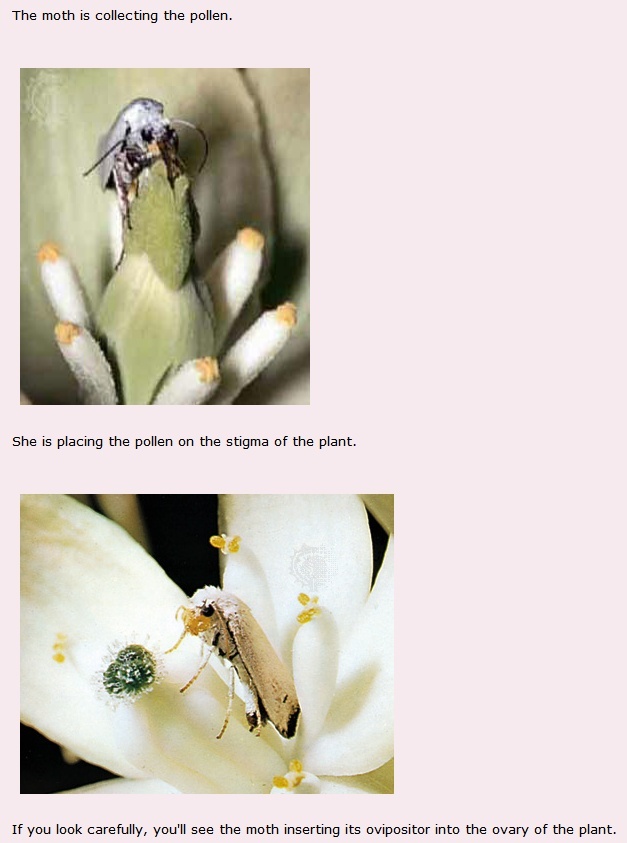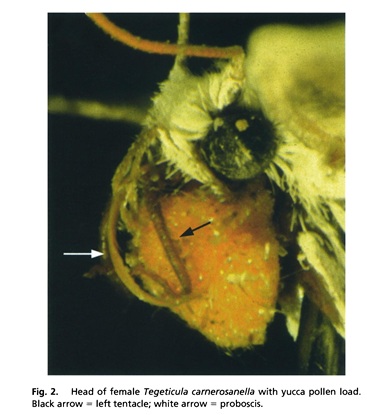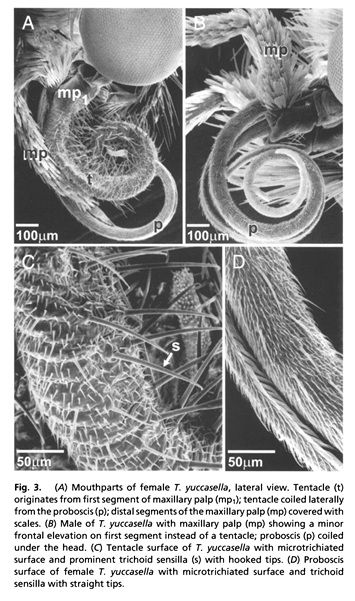https://www.youtube.com/watch?v=dUacHShPqCM
https://www.apologeticspress.org/apPubPage.aspx?pub=2&issue=945&article=1424
The pollination of yucca plants is different from all other plants. The flowers of yucca plants can only be pollinated by yucca moths. When a female yucca moth collects pollen from the yucca flower, she then bores holes and lays eggs in the base of the female part of the flower. Afterwards, the moth flies to the top of the flower and crawls onto the stigma, where she unloads the flower’s pollen in order for pollination to occur.

Soon, the yucca flower will be able to produce seeds. In the meantime, the yucca moth eggs will have hatched. The moth caterpillars survive by eating some of the seeds of the yucca plant, which is all they eat—yucca seeds and yucca seeds only. But the caterpillars do not eat allof the seeds. Many seeds are left to fall to the ground to become new yucca plants.
So, yucca moths need yucca plants and yucca plants need yucca moths? Exactly! The relationship between the Yucca plant and the Yucca moth is a mutualistic relationship or interdependence. How could they have evolved independently ? This grand design and dependence on each other for survival testifies to a Grand Designer.
THE LIFE HISTORY OF THE YUCCA MOTH
http://www.thenakedscientists.com/forum/index.php?topic=16535.0
The adult female moth emerges from the ground in June through July, at the time that the yucca plant is in flower (!!!), and mates shortly after emergence.
She collects the pollen of a yucca plant, using her specially shaped mouthparts, shaping it into a kind of horseshoe-shaped mass. She then flies to another inflorescence (on another plant.) There, she selects a flower, inserts her ovipositor through the wall of the carpel, and lays an egg next to the developing ovules.
She then climbs to the top of the style, and, using her specially shaped mouthparts, called maxillary tentacles (which are unique to the yucca moth), she actively transfers the pollen on to the top of the stylar canal. She repeats the process, several times, thus ensuring that the plant is adequately pollinated, and can produce seeds on which the survival of her young, and the plant, depends.
She then drops off the plant and dies.
The eggs hatch out into larvae after 7 -10 days, and they feed on the developing seeds, leaving one uneaten. After about 40 days, the 4th instar larvae eat their way out of the developing fruit, and drop to the ground using a silken thread. They then burrow their way into the soil, pupate after a year or so, and emerge as adults at the time of the flowering of the yucca plant.
The instinctive behaviours in this life history are nothing short of astounding.
Consider:
1 The young never see their mother or father, and therefore cannot copy what they did. They are born with the behaviour somehow programmed into their genes.
2 The female moth somehow knows that pollination of the flower is essential to the formation of the seeds, which are going to become the food for her offspring. She knows where the pollen needs to be placed in order to effect fertilisation.
3 Her mouthparts are shaped precisely to create the mass which is to fit into the stylar canal.
4 She somehow knows that the ovary contains the food her developing larvae will need to eat. If the plant is not pollinated, the seeds cannot develop.
5 The larvae, it has been observed, never eat all of the developing seeds, but always leave one or more to perpetuate the plant.
6 She ensures cross-pollination of the flowers, by flying from one plant to another after collecting the pollen.
7 The larvae, the grubs, pupate. That means, they dissolve entirely into a fluid within the pupal case, and reform into a flying creature, the moth. This by itself is a major, miraculous feat.
8 The pupae hatch out in June/July, at the very time that the yucca plant is in flower. Although they were underground, they are somehow aware of the correct time to hatch out and fly.

I have used the word ‘knows’ several times in this account. A moth cannot ‘know’
1 How to dissolve its grub character into a fluid enclosed in a case which is somehow going to reconstitute itself into a flying moth fully armed with instincts.
2 When to emerge at exactly the right time that the yucca plant is flowering
3 That pollination is essential to the fertilisation of the seeds and the survival of her larvae. How could she know? She never lives long enough to see either take place.
4 That the pollen she collects with her peculiarly shaped mouthparts is shaped exactly correctly to fit the stylar canal.
5 That the ovary contains ovules, which are going to develop into seeds on which her young can feed.
6 That cross pollination will ensure the continuance of the yucca plant
7 If the larvae do not have the silk thread, they would probably perish on impact with the ground.


Without the moth, the yucca species will perish. Without the yucca, the moth will perish. Each is entirely dependent on the other for its survival, because the moth lives on no other plant, and the plant is not fertilised by other insects. No moth, no yucca. No yucca, no moth.
The instinct displayed defies belief. Yet several reputable observers have described the behaviour in detail and published their findings, mithering foolishly about 'co-evolution' when they try to explain the origin of the behaviour.
It's like a lock and a key. Without the key, the lock is useless. Without the lock, the key is useless. Both have to be present at the same time for the device to work - and both are the work of an intelligent designer.
Here, we have several miracles rolled into a single life cycle. The moth would perish without the plant, and the plant would perish without the moth. Which came first? Answer: neither. They appeared there at the same time, fully formed and fully functioning. There's no evolution here, that's for sure.
http://phylodiversity.net/azanne/csfar/images/f/f1/Pellmyr2002.pdf[/b]
https://www.apologeticspress.org/apPubPage.aspx?pub=2&issue=945&article=1424
The pollination of yucca plants is different from all other plants. The flowers of yucca plants can only be pollinated by yucca moths. When a female yucca moth collects pollen from the yucca flower, she then bores holes and lays eggs in the base of the female part of the flower. Afterwards, the moth flies to the top of the flower and crawls onto the stigma, where she unloads the flower’s pollen in order for pollination to occur.

Soon, the yucca flower will be able to produce seeds. In the meantime, the yucca moth eggs will have hatched. The moth caterpillars survive by eating some of the seeds of the yucca plant, which is all they eat—yucca seeds and yucca seeds only. But the caterpillars do not eat allof the seeds. Many seeds are left to fall to the ground to become new yucca plants.
So, yucca moths need yucca plants and yucca plants need yucca moths? Exactly! The relationship between the Yucca plant and the Yucca moth is a mutualistic relationship or interdependence. How could they have evolved independently ? This grand design and dependence on each other for survival testifies to a Grand Designer.
THE LIFE HISTORY OF THE YUCCA MOTH
http://www.thenakedscientists.com/forum/index.php?topic=16535.0
The adult female moth emerges from the ground in June through July, at the time that the yucca plant is in flower (!!!), and mates shortly after emergence.
She collects the pollen of a yucca plant, using her specially shaped mouthparts, shaping it into a kind of horseshoe-shaped mass. She then flies to another inflorescence (on another plant.) There, she selects a flower, inserts her ovipositor through the wall of the carpel, and lays an egg next to the developing ovules.
She then climbs to the top of the style, and, using her specially shaped mouthparts, called maxillary tentacles (which are unique to the yucca moth), she actively transfers the pollen on to the top of the stylar canal. She repeats the process, several times, thus ensuring that the plant is adequately pollinated, and can produce seeds on which the survival of her young, and the plant, depends.
She then drops off the plant and dies.
The eggs hatch out into larvae after 7 -10 days, and they feed on the developing seeds, leaving one uneaten. After about 40 days, the 4th instar larvae eat their way out of the developing fruit, and drop to the ground using a silken thread. They then burrow their way into the soil, pupate after a year or so, and emerge as adults at the time of the flowering of the yucca plant.
The instinctive behaviours in this life history are nothing short of astounding.
Consider:
1 The young never see their mother or father, and therefore cannot copy what they did. They are born with the behaviour somehow programmed into their genes.
2 The female moth somehow knows that pollination of the flower is essential to the formation of the seeds, which are going to become the food for her offspring. She knows where the pollen needs to be placed in order to effect fertilisation.
3 Her mouthparts are shaped precisely to create the mass which is to fit into the stylar canal.
4 She somehow knows that the ovary contains the food her developing larvae will need to eat. If the plant is not pollinated, the seeds cannot develop.
5 The larvae, it has been observed, never eat all of the developing seeds, but always leave one or more to perpetuate the plant.
6 She ensures cross-pollination of the flowers, by flying from one plant to another after collecting the pollen.
7 The larvae, the grubs, pupate. That means, they dissolve entirely into a fluid within the pupal case, and reform into a flying creature, the moth. This by itself is a major, miraculous feat.
8 The pupae hatch out in June/July, at the very time that the yucca plant is in flower. Although they were underground, they are somehow aware of the correct time to hatch out and fly.

I have used the word ‘knows’ several times in this account. A moth cannot ‘know’
1 How to dissolve its grub character into a fluid enclosed in a case which is somehow going to reconstitute itself into a flying moth fully armed with instincts.
2 When to emerge at exactly the right time that the yucca plant is flowering
3 That pollination is essential to the fertilisation of the seeds and the survival of her larvae. How could she know? She never lives long enough to see either take place.
4 That the pollen she collects with her peculiarly shaped mouthparts is shaped exactly correctly to fit the stylar canal.
5 That the ovary contains ovules, which are going to develop into seeds on which her young can feed.
6 That cross pollination will ensure the continuance of the yucca plant
7 If the larvae do not have the silk thread, they would probably perish on impact with the ground.


Without the moth, the yucca species will perish. Without the yucca, the moth will perish. Each is entirely dependent on the other for its survival, because the moth lives on no other plant, and the plant is not fertilised by other insects. No moth, no yucca. No yucca, no moth.
The instinct displayed defies belief. Yet several reputable observers have described the behaviour in detail and published their findings, mithering foolishly about 'co-evolution' when they try to explain the origin of the behaviour.
It's like a lock and a key. Without the key, the lock is useless. Without the lock, the key is useless. Both have to be present at the same time for the device to work - and both are the work of an intelligent designer.
Here, we have several miracles rolled into a single life cycle. The moth would perish without the plant, and the plant would perish without the moth. Which came first? Answer: neither. They appeared there at the same time, fully formed and fully functioning. There's no evolution here, that's for sure.
http://phylodiversity.net/azanne/csfar/images/f/f1/Pellmyr2002.pdf[/b]

